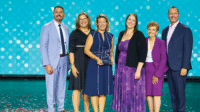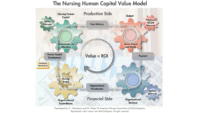ANA Innovation is changing the way nurses look at systems through its Innovation Advisory Board and Committees.
Systems thinking represents an effective tool for understanding the continuity of and creating better solutions for the healthcare delivery process. As the largest group of healthcare professionals, nurses are uniquely positioned to use this tool to design new products and models of care delivery. The systems thinking approach looks at how the components of a system interact with one another and the outcomes of that system can be improved.
The American Nurses Association (ANA) Innovation Advisory Board (IAB) and Innovation Advisory Committees (IACs) are bringing together thought leaders from the nursing and innovation communities to create an infrastructure of knowledge, connectivity, and resources to enable nurses to navigate, lead, and respond to complex and multifaceted problems. The committees draw from the expertise of its members to create innovative solutions and forward-thinking possibilities for the nursing profession.
“The dynamic changes happening within healthcare organizations and across the broader healthcare ecosystem will continue to build over the next decade,” said Oriana
Beaudet, DNP, RN, PHN, vice president of Nursing Innovation at ANA. “The nurses and healthcare organizations who step
forward to embrace change and complexity will be positioned
as industry leaders moving into the future.”
ANA recently spoke with two committee leaders to discuss how systems thinking informs their work.
From nursing education to patient engagement
“It’s natural for nurses to adopt a systems thinking perspective,” said Kendra Ripp, DNP, RN, CPHQ, chair of the IAB New Care Delivery Models committee. Ripp has worked in quality improvement and program design for much of her career.
“When treating a patient, we’re considering their environmental factors and their family and home situation,” she said. “Do they have support to be able to manage their condition? What if they experience side effects from their medication?”
In her current role as vice president of clinical services at Nice Healthcare, a company that provides in-home and virtual primary care, mental health therapy, and physical therapy, Ripp sees that the connection between traditional nursing education and the changing healthcare delivery landscape needs to evolve.
“Virtual care is a very different skill set that has to be taught,” Ripp said. “As it becomes more mainstream, we need to start educating the nursing workforce differently.” However, standing in the way of doing so is the nursing faculty shortage, she explained. “We want to encourage more nurses to go into academia,” Ripp said. “We as nursing leaders and innovators need to take a step back to look at the current system as a whole to explore how to solve this problem.”
Another area ripe for innovation is patient engagement. At Mount Sinai Health System in New York, where Robbie Freeman, MSN, RN, NE-BC, is vice president of clinical innovation and chief nursing informatics officer (CNIO), patients frequently reported trouble keeping track of next steps after a visit with their care team. Freeman brought together frontline nurses, providers, and patients to develop an interactive guide to help patients stay on track.
Freeman, who chairs the IAB’s Data Science, AI, and Augmented Intelligence committee, and his team at Mount Sinai have launched a 3-year initiative focused on digital transformation. They’re developing machine learning and artificial intelligence (AI) products to use across hospitals and their ambulatory network. “We’re taking a co-design approach with our frontline team to create tools that can allow us to get the right resource to the right patient at the right time,” Freeman said. These efforts have resulted in an AI tool that identifies malnourished patients who would benefit from a registered dietician consult, and an AI-driven assessment tool that identifies patients at higher risk for falls. These innovations allow nurses and other providers to focus their time and energy on those patients who will benefit from specialized care, Freeman said.
ANA Enterprise resources on innovation
The ANA Enterprise aims to build a culture of innovation across the nursing profession. We offer a range of interactive resources and learning and connection opportunities to support and nurture the innovative, curious, and pioneering nature of nurses.
ANA Innovation Lounge. A series of interactive discussions with innovators, creators, and experts as they reflect on the nursing profession and healthcare through a lens of innovation.
NursePitch™. An interactive event cosponsored by ANA and the Healthcare Information and Management Systems Society. NursePitch™ offers prize monies and features nurses sharing their creative solutions and innovations involving a medical device or technology.
Innovation Blog. Nurses involved in innovative products, designs, and ideas share their experiences and insights on their journey of innovation.
See You Now Innovation Podcast. Offered by ANA and Johnson & Johnson, See You Now shares nurses’ innovative and human-centered solutions for today’s most challenging healthcare problems.
ANA Innovation Community. A vehicle for ANA members interested in connecting to, networking with, and learning alongside other nurses interested in using innovation to improve processes and care delivery, develop new programs, and find novel ways of providing education. Guided by community manager Consuela (Coni) Dennis, MSN, RN, NE-BC, a Kentucky Nurses Association member. (community.ana.org/home)
Education, Research, Resources. A collection of webinars, free podcast CNE, and research involving innovation. Links to a video library, books, and articles on a range of innovation topics.
ANA Innovation Awards. The ANA Innovation Awards sponsored by Stryker highlight, recognize, and celebrate nurse-led innovation that improves patient safety outcomes. Cash prizes recognize an individual nurse and a nurse-led team whose product, program, project, or practice best exemplify innovations in categories such as care delivery models and new business, programs, or services.
Stay in the know about all ANA Enterprise innovation activities—sign up for The Gutsy Innovator, a monthly newsletter dedicated to all things innovation at the association.
Find resources via the ANA Innovation web page at nursingworld.org/innovation.
Preventing errors
When cases of healthcare provider errors make the news, talk of systems or procedure changes often follow. Technology plays a role in reducing errors, Freeman said, but it should be driven by systems thinking. “It’s all about making sure that our care teams are involved in the design” of safety tools, he said. “They need to have a voice in developing solutions that we support with technology.”
And although technology has a role to play, said Freeman, an ANA-New York member, “It has to be in combination with a transparent culture where people feel supported and know that they can speak up without the risk of punitive action.” Just Culture is a best practice, but it has to be driven by leaders. “Technology has come a long way as a means to prevent errors but having a culture that supports reporting and celebrates good catches is even more critical,” Freeman explained.
Ripp added, “Creating a culture where providers feel safe in reporting errors along with near misses helps build in additional defenses to prevent harm.” Rather than a culture of shame and blame on the individual, she noted, we need to look at the broader context of how and why errors occur.
Making connections
The IAC Data Science, AI, and Augmented Intelligence committee includes thought leaders from across the country, from academia and academic medical centers, and nursing experts working in the field. The committee is developing a toolkit for the nursing community with the goal to provide a resource for those who are interested in combining their nursing knowledge and experience with analytics, AI, and data science to help support incorporating these tools and competencies into their own practice, according to Freeman.
On the New Care Delivery Models committee, Ripp sees the diversity of roles and geographic locations among members as a plus. “We have nurses on the committee who are working in health systems, insurance providers, academia, and many different models of care,” she said. “And they’re from all over the country, which is important because healthcare is regional. Different innovations happen depending on the space and place you’re in.”
“When you create a new care model, you have to take into account technology, communication, entrepreneurship, regulatory issues, funding, policy, social determinants of health, and education,” Ripp said. Her committee is currently surveying the landscape of care delivery trends to develop a toolkit of resources that include these systems thinking considerations for nurse innovators.
The future of nursing innovation
Both Ripp and Freeman agree that the future of nursing innovation is bright.
“I’ve been seeing more nurse-led startups lately, and I’m really impressed,” Freeman said. He also is aware of more organizations adopting the CNIO role to drive technology and innovation across their enterprises, which is bringing nurse leaders to the table with other executives.
Ripp believes now is a generative time for nursing innovation. “The silver lining of the pandemic is that it encouraged us to come up with ways to do things differently,” she said. “We saw that the systems of care that we have in place were not reaching everyone who needs them, and we came up with innovative ways to provide care.”
Making innovation and systems thinking a priority can only benefit the future of nursing, according to Freeman. “The challenges we’re facing in the nursing workforce right now are putting the right leaders in place and making sure they have support behind them so they can drive change and support our frontline nursing teams with the tools and technology that are critical to everything we do.”
Freeman asserted that nurses who want to bring innovative solutions to their teams should take the initiative. “We can’t expect others to do it for us,” he said. “Think about how to put together a business case for the problem you want to solve. Be able to articulate the value it’s going to bring.” That value doesn’t have to be financial—it can be around engagement, safety, quality, or other needs. “You need to show how you’re going to move that needle,” Freeman emphasized.
Ripp agreed that the future of healthcare innovation is in nurses’ hands because they see things from a systems perspective.
“If we’re constantly taking shortcuts or making modifications to a system,” Ripp said, “that means that the system isn’t working the way that we need it to.”
— Elizabeth Moore is a content creator at ANA.
American Nurse Journal. 2022; 27 (11). Doi: 10.51256/ANJ112236


















